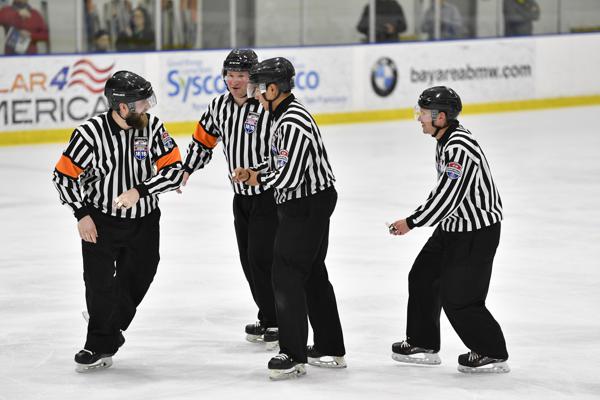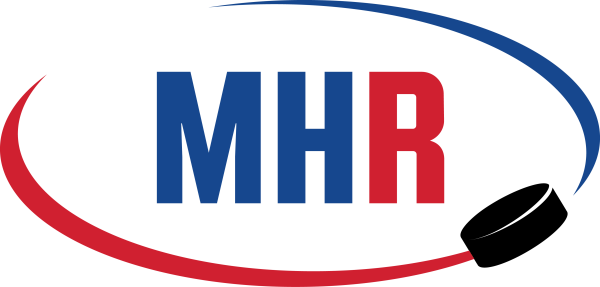
USA Hockey Responds to Hockey Community with 2025-29 Rule Changes
USA Hockey Photo
By Scott Lowe – MYHockeyRankings.com
It happens every four years.
And while the process doesn’t generate quite as much interest or debate as a presidential election, the last set of USA Hockey rule changes in 2021 certainly turned a few heads and created a great deal of concern and skepticism among various constituents in the youth hockey community. Now, as we prepare to enter the 2025-26 campaign with new rule modifications on the horizon, what conclusions can we draw from those last changes and what lies ahead?
As with most issues in 2025, opinions about the impact and effectiveness of the 2021 alterations can vary considerably depending on who you ask. But with USA hockey at least partially walking back two of those modifications, it’s safe to say that the changes produced a mixed bag of results.
First, let’s take a look back at the groundbreaking rule changes that were introduced prior to the 2021-22 season.
In the words of USA Hockey:
- “Language has been updated to emphasize the principles outlined in the ‘Declaration of Safety, Fair Play and Respect.’ These include eliminating hits that are meant to punish or intimidate an opponent or where there is no effort to win possession of the puck.”
- “The offside rule eliminates tag-up offside at all Youth and Girls levels of play. Immediate offside is now applied at all levels except High School and Adult classifications.”
- Also, “players may not ice the puck while on the penalty kill, with High School and Adult classifications being excluded.”
- And finally, “changing ‘body contact’ to ‘competitive contact,’ incorporating language from the Declaration of Safety, Fair Play and Respect. This is to emphasize any contact within the sport as being competitive in nature, with aims to possess the puck, and is encouraged at all levels of play.”
Almost immediately after the changes were announced, there was public outcry from coaches and officials, mostly in response to the penalty killing and offside alterations.
In general, the criticism from coaches was directed at not teaching kids to play the way they were going to be playing if they went on to advance to junior, college or professional hockey. The thought was that we weren’t teaching them to play “real hockey.”
Coaches and officials also feared that the no-tag offside rule would hurt the flow of the game, while referees, rink managers and coaches alike were concerned that more whistles would lead to longer games, which could create scheduling issues if contests rant past their allotted time slots.
Then there was the added burden on officials, which often seems to be ignored when rule changes are made.
With so many leagues, levels and sanctioning bodies these days – combined with the ongoing shortage of officials – referees and lines people might work four or five games a day and be asked to apply multiple sets of rules. This almost certainly led to confusion, honest mistakes and increased tension among fans, coaches and officials. As fatigue from working so many games set in, there’s little doubt that the mistakes and tension grew.
Of course, the added layer of subjectivity introduced with the body contact rules didn’t make it any easier on the folks wearing stripes either.
“The whole thing has made it confusing for players and officials,” said one official who works youth, high school, junior, college and professional games. “I like to say that I work high school hockey because it’s ‘real hockey,’ but the players are confused and constantly ask if they can ice the puck on the PK and if they are playing tag-up. Officials are getting mixed up early in games, so we have discussions in the room beforehand to remind guys what rules we are playing.”
Another official addressed the tension created by having to manage and understand multiple rulebooks.
“At first, mistakes definitely were made,” said Brent Kendall, a longtime youth, high school, junior and college referee. “This definitely created tension with the coaches and players. What made it worse was that if the mistake was made, 99 percent of the time it did not go back to center for the faceoff. Most coaches didn’t know that. The shortage of officials also didn’t help when guys were working three to five games a day at different levels and for different leagues. Being tired definitely leads to more errors.”
Both officials contacted for this article indicated that they worked games that ran past their allotted time slots and were abruptly cut short.
As for body contact, the USA Hockey rules changes produced mixed results given that many players compete in and officials officiate in different leagues and levels that approach physical play differently.
“Yes, hitting is down, but when big hits do happen everyone gets mad because they got hit hard and don’t understand why it’s not a penalty,” the first official said. “We are constantly having to remind people that just because it’s a big hit doesn’t mean it’s a penalty.”
The other official offered a simple solution to some of the body contact issues.
“We should just go back to introducing at least some form of checking at the 12U level,” Kendall said. “It’s not taught at a young enough age. They are thrown into it at age 14 and there can be a huge size difference among players in that group. I just don’t think they are physically prepared for it, and when a big hit happens there is retaliation. That leads to more penalties. And many officials are calling penalties because a hit produces a loud noise. They don’t really understand what a good hit is.”
Coaches don’t seem to have backed away from some of the concerns they had when the changes were announced four years ago.
“It honestly slowed down the games and made it easier for less-talented teams to win games,” said a coach from a Tier 1 youth academy program. “If you had a slower team or a shorter bench, they could slow the game down and allow themselves to get 20 or 30 seconds of rest when they needed it. At the end of the day, we should be teaching players who are going into junior and college hockey by having them play their rules.”
The good news is that USA Hockey does have a process that allows for rules alterations every four years, and it seems as though the governing body may have drawn at least some conclusions similar to those voiced by the coaches and officials.
When the rules adaptations for the 2025-29 seasons were introduced a few months ago, the two most prominent alterations stood out:
- The delayed or tag-up offside rule is being reinstituted at the 15O Youth level and above and the Girls 16U level and older.
- Youth teams at the 15O level and above and Girls teams at the 16U level and above will be allowed to ice the puck when killing penalties.
While USA Hockey isn’t completely walking back its decision from four years ago, clearly the organization is listening to feedback from coaches and officials and taking steps to help players in older age groups better prepare for the junior and college levels.
“Both of these rules have involved passionate discussion across the country with a wide variety of opinions,” USA Hockey posted on its website. “USA Hockey is focused on providing the best experience for its players and ensuring it utilizes consensus sport science related to development as a guiding principle. USA Hockey also understands that providing our players the best experience needs to include doing the best job we can to prepare them for whatever the next step in their hockey journey might be. It is fair to say that the modification of the two particular rules we’re talking about is a middle ground that our Congress felt good about after listening carefully to the varied constituent groups.”
This seems to be a fair conclusion and compromise that provides players who want to keep playing beyond 18U and 19U several years to prepare for their jump to the next level.
It seems a bit odd that there will be teams competing for USA Hockey national championships at the 13O and 14U levels who will be playing different rules than those 15 and older, but if the organization believes strongly in the benefits of having younger players observe those rules, there always is going to be a transition at some point of the development cycle.
USA Hockey posted its reasoning for eliminating the tag-up offsides rule when the change was made in 2021.
“It’s important that those playing defense learn how to gather the puck, look up and find either an outlet pass or a way to possess the puck for their team up ice. Additionally, the emphasis on forwards finding creative solutions in the neutral zone while not dumping the puck with a teammate who is offside will be an added benefit for our players.”
The governing body also supported its decision to eliminate icing in shorthanded situations.
“This is another instance of Youth and Girls hockey rules being created to develop better hockey players, and to create a game that is more fun and competitive for players. This rule change keeps normal competitive situations, such as working to creatively possess the puck to center ice prior to dumping the puck or advancing into the offensive zone. Players can still send the puck down the ice, but this rule change encourages players to do so with greater intent and incentivizes players to think through difficult situations while down a player instead of thinking the only option is to throw the puck down the ice. They will have to think through solutions such as finding an open teammate, clearing the puck partially down the ice or even possessing the puck to center ice before dumping it into the opponent’s end. This will also provide a proper advantage to the power play, which has earned the offensive advantage by forcing a penalty.”
There is validity to each of these points, and there are many coaches out there who agree with the premise and support those changes even as USA Hockey seeks to modify them slightly.
Topher Scott is a well-known hockey personality on social media. He founded the Hockey Think Tank, an organization “dedicated to educating and inspiring hockey players, parents, coaches and organizations through a variety of resources.” He is a former NCAA Division I hockey coach who produces a podcast that has been downloaded more than a million times.
Scott has been outspoken in his support of some of the changes that were made by USA Hockey four years ago. In a recent post on Twitter/X he explained why he likes the penalty kill no-icing rule.
- “Clearing a puck on an icing at the higher levels is often a multiple-player job, not a one player job. Pressure is coming hard (they have more players than you) so a pass is often made to a teammate before the puck is cleared. The art is learning how to clear as a team, not just as an individual …”
- “It forces players without the puck to support it. And if you want to develop hockey sense in your players, creating conditions where you have to anticipate without the puck is massively important. This rule promotes that. And anytime you can promote more passing and decision-making, I'm all for it.”
- “It forces players to communicate. It's a great habit to emphasize as a coach as again there's less time and space/options to make a play with this rule. Communication and puck support are the foundations of team play.”
- Not only does it promote decision-making as I laid out above, but it promotes skill development. You have to be more evasive in your skating/edges, you have to give and receive more passes and you have to handle the puck more in tight areas. This makes players better …
- “Youth hockey shouldn't completely resemble what hockey at the older ages look like. It's okay if it doesn't look like real hockey when it's developmentally appropriate.”
Obviously, there are strong arguments to be made in support of all sides of these rule issues. They key is to have a process in place by which hockey’s leadership can address concerns about rules and their impact on player development and safety, make occasional changes and circle back after an ample period of time to analyze the impact and end results of those changes.
And to tweak the rules again if necessary.
That’s what USA Hockey has in place, and 2025-26 provides another opportunity for us to implement and analyze rule changes that hopefully will benefit the players and the sport long term.
Here is a more complete summary of the USA Hockey rule changes for 2025-29 that will be most noticeable:
- Tier I teams may roster and dress 22 players in Youth 15O, 16U, 18U and Girls 19U.
- All neck-laceration protectors must be HECC certified while allowing BNQ certified protectors through the 2026-27 season.
- Officials and disabled players under 18 must wear neck laceration protectors.
- A two-minute bench minor will be assessed when a team challenges a player not wearing a mouthpiece and it is verified by an official.
- There will be no mandatory minor penalty assessed to a goalkeeper who shoots the puck out of the playing area.
- In Youth 15O and above and Girls 16U and above, teams will be allowed to ice the puck while playing shorthanded.
- In Youth 15O and above, Girls 16U and above, delayed offsides will be enforced.
- A kneeing penalty will add a mandatory 10-minute misconduct to the assessed minor penalty.

